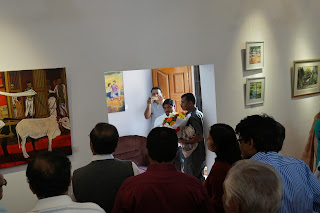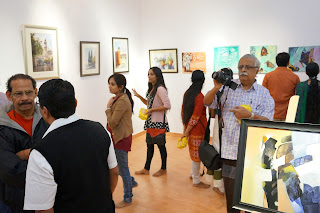When one hears the phrase “South Indian Traditional paintings” possibly the first style of paintings that come into our mind is Tanjhavur/ Tanjore paintings with heavy gold decorations etc. There is a sister art to this art form, which in my eyes are much subtler and finer – the mysore paintings. Both these art forms are derivatives of other traditional art forms.
[Pic: A modern Tanjore painting with Thai figure. Artist: Bindu P V]
The Mysore kings were ruling the princely state from Srirangapattana and Raja Wodeyar (1578-1617 A.D.) employed several painters from Vijayanagar and thus laid a sound foundation of Mysore Traditional Painting. These painters were also assigned allied work in decoration, preparing banners, doll making, gold work, painting the temple cars, preparing portraits of rulers, deities and saints. The Mysore kings that followed also encouraged this style of painting.
[Pic: Durbar in Mysore Palace. Image from: http://www.mysorepalace.gov.in/]
[Pic: A portion of a Mysore painting composition of Girija Kalyanam. Artist: Bindu P V]
These artists used locally available material for their paintings. The hair of the squirrel were used as brushes by tying them with a silken tread and inserting them in the narrower end of a quill. The board for painting were obtained by pasting a cloth or waste paste to wooden planks. Controlled- burnt tamarind sticks were used as sketching charcoal. The sky and river were painted followed by animal and human figures. The gold (gesso) foils are pasted last. In southern India, two types of gesso art are found predominantly, namely the Tanjore gesso works and the Mysore gesso works, . This comparison chart of the two traditional schools of classical Indian painting are provided to so you can appreciate the difference between their history and styles.
[Pic: Part of paintings of Shri Rama and Maha Vishnu from Tanjore and Mysore paintings respectively]
Comparing Tanjore (a.k.a. Tanjavur) and Mysore style of gesso paintings
Comparing Tanjore (a.k.a. Tanjavur) and Mysore style of gesso paintings
In my observation, semi precious stones, Kudan stones etc were not added to the mysore paintings like that in Tanjore paintings
[Ref: http://www.kamat.com]













































